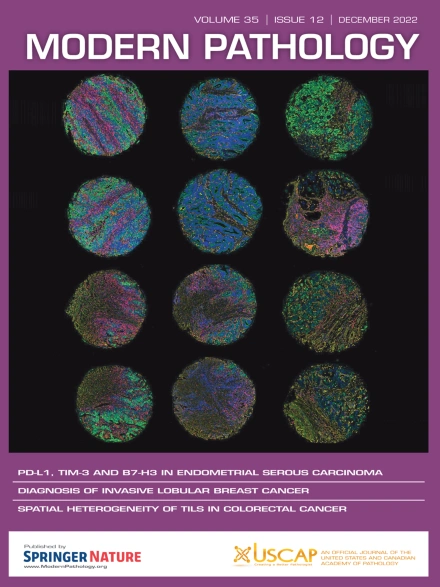Prognostic Implications of Magee Equation 3 and Residual Cancer Burden in Patients Receiving Neoadjuvant Chemotherapy for Hormone Receptor-Positive HER2-Negative Breast Cancer
IF 7.1
1区 医学
Q1 PATHOLOGY
引用次数: 0
Abstract
Breast cancer (BC) presents significant molecular heterogeneity, complicating prognosis and treatment strategies. Although molecular testing enhances our understanding of BC, high costs can limit accessibility in certain health care settings. This retrospective cohort study evaluates the prognostic value of Magee equation 3 (ME3) and residual cancer burden (RCB) in patients with hormone receptor-positive, human epidermal growth factor receptor 2-negative BC treated at the Instituto do Câncer do Estado de São Paulo from January 2011 to January 2024. We included 203 women, with a mean age of 50.2 years, diagnosed with hormone receptor-positive, human epidermal growth factor receptor 2-negative BC (stages I-III), who completed neoadjuvant chemotherapy followed by surgery. ME3 scores were categorized as low (<18), intermediate (18-25), and high (>25), whereas RCB was classified into 4 groups (0, 1, 2, or 3). Associations between ME3 and RCB categories were analyzed using χ2 and Cochran-Mantel-Haenszel tests. Overall survival (OS) and disease-free survival (DFS) were assessed using the Kaplan-Meier method with log-rank tests. Prior to neoadjuvant chemotherapy, 60.1% of patients had tumors >5 cm, 69.5% had positive lymph nodes, and 85.7% had invasive carcinoma of nonspecial type, with a mean Ki67 index of 35.5%. Analysis revealed that 22.2% of patients had ME3 >25, 39.9% had ME3 18-25, and 37.9% had ME3 <18. A significant inverse association was found between RCB and ME3 (P < .0001). At a median follow-up of 91.4 months (range: 8-157 months), significant associations were noted for OS (log-rank P = .0059) and DFS (log-rank P = .0028) with ME3 categories; patients with low ME3 showed better outcomes. In patients with RCB-3, those with ME3 <18 had a lower risk of recurrence compared with those with ME3 18-25 (hazard ratio: 4.70, 95% CI: 2.00-11.02; P = .0004) and ME3 > 25 (hazard ratio: 5.18, 95% CI: 1.85-14.15; P = .0017). Similarly, lower risks of death were observed for ME3 < 18 versus higher ME3 categories. In conclusion, ME3 significantly correlates with OS and DFS, suggesting that it may serve as a valuable alternative to molecular assays in resource-limited settings. Combining ME3 with RCB enhances individualized risk stratification, providing a more precise prognostic assessment for patients with high RCB.
Magee方程3和残余癌症负担对hr阳性her2阴性乳腺癌接受新辅助化疗患者的预后影响
乳腺癌(BC)具有明显的分子异质性,使预后和治疗策略复杂化。虽然分子检测增强了我们对BC的了解,但高昂的成本限制了某些医疗机构的可及性。这项回顾性队列研究评估了2011年1月至2024年1月期间在圣保罗州立大学癌症研究所治疗的hr阳性、her2阴性BC患者的Magee方程3 (ME3)和残余癌症负担(RCB)的预后价值。我们纳入203名女性,平均年龄50.2岁,诊断为hr阳性,her2阴性BC (I-III期),完成新辅助化疗(NAC)后进行手术。ME3评分为低(25分),而RCB分为四组(0、1、2、3)。使用卡方检验和Cochran-Mantel-Haenszel检验分析ME3和RCB类别之间的相关性。总生存期(OS)和无病生存期(DFS)采用Kaplan-Meier法和log-rank检验进行评估。NAC术前,60.1%的患者肿瘤面积为0.5 cm, 69.5%的患者淋巴结阳性,85.7%的患者为非特殊型浸润性癌,平均Ki67指数为35.5%。分析显示,22.2%的患者ME3≥25,39.9%的患者ME3≥18,37.9%的患者ME3 < 18。RCB与ME3呈显著负相关(p 25 (HR: 5.18, 95% CI 1.85-14.15;P = 0.0017)。同样,ME3 < 18的患者与ME3较高的患者相比,死亡风险较低。综上所述,ME3与OS和DFS显著相关,这表明在资源有限的情况下,ME3可能是一种有价值的分子检测替代方法。ME3联合RCB可增强个体化风险分层,为高RCB患者提供更精确的预后评估。
本文章由计算机程序翻译,如有差异,请以英文原文为准。
求助全文
约1分钟内获得全文
求助全文
来源期刊

Modern Pathology
医学-病理学
CiteScore
14.30
自引率
2.70%
发文量
174
审稿时长
18 days
期刊介绍:
Modern Pathology, an international journal under the ownership of The United States & Canadian Academy of Pathology (USCAP), serves as an authoritative platform for publishing top-tier clinical and translational research studies in pathology.
Original manuscripts are the primary focus of Modern Pathology, complemented by impactful editorials, reviews, and practice guidelines covering all facets of precision diagnostics in human pathology. The journal's scope includes advancements in molecular diagnostics and genomic classifications of diseases, breakthroughs in immune-oncology, computational science, applied bioinformatics, and digital pathology.
 求助内容:
求助内容: 应助结果提醒方式:
应助结果提醒方式:


